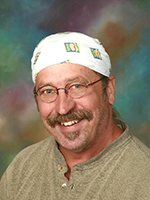Proactive Grieving
Author: Mitch Carmody
And how we climb the S.T.A.I.R.S to get there
When my father died in 1969, I was only 15 years old. My mom told me that I was the man of the family now and that I needed to take care of the farm and my sisters. I did just that. I did not grieve, I did not cry, I did not publicly mourn. I hid my sorrow as if it were some awful secret I was ashamed of. I moved on.

When my brother died five years later, nothing much had changed. My brother had been hospitalized as a ward of the state since early childhood. Because he had been born severely handicapped, his death was regarded as a divine mercy by most, and we thanked God that he was released from his torment. Still, I did not mourn.
Nine years after that, my twin sister and her two young sons were killed in an auto accident. Her husband celebrated the fact they had gone to be with Jesus, and there was very little display of public mourning. I did not mourn.
Three years later, my son Kelly died of cancer, and I defaulted to how I was raised to react. Buck up and get over it. I stuffed my grief and blended back into the real world. I was good at it.
But I started to realize that stuffing all my losses had crippled my spirit. I had no zest, no vision, and no color in my life. I felt defeated and lost in a world of different shades of gray. Although not suicidal, I certainly felt that I would embrace the angel of death and not fear his sting.
Then one day I walked past a photo of my son and looked into his face for a long time. Paralyzed and lost in reverie, I started to shake, then scream, then cry, crumbling to the floor in unbounded agony. I cannot do this! I screamed. I made a conscious decision right then and there to dive back into my grief, starting with my father and continuing right up to my son.
I embraced my grief, engaged my spirit, honored my child, and began to actively mourn my loss. I shared my continued pain with my family, my friends, and my co-workers. I talked about Kelly, wrote a book, and started to create works of art again. By proactively working on my grief, I started to heal and again felt purposeful and (dare I say) even happy at times. I had started a new relationship with my dead son, and found it was good. Our loved ones die a second death when no one speaks their name.
I believe we are ready for a paradigm shift in processing grief in this country, and it’s happening now. Since 2002, I have seen a subtle transformation taking place—almost a pride in ownership of one’s own grief. This is my grief, my journey, as long as it takes. I accept its challenge, and the world will have to accept that this is who I am and how I am dealing with my loss; it’s how I survive.
I believe there are no predictable linear stages in processing the death of a loved one. Rather, I believe the grief journey is a series of steps negotiated one at a time, each one taking as long as it takes to reach the next. No timetable, no shortcuts, no false expectations, no failures. Just one step at a time, forward and back, climbing the S.T.A.I.R.S. when we are ready, willing, and able. Each step takes as long as it takes and is different for everyone. Whether the death was the result of a long-term illness, a sudden unexpected accident, murder, or suicide, we who are left behind will have to climb this stairway.
Active participation in our grief journey is paramount to survival. If we want to feel good again, feel joy again, feel part of the world again, we should strive to become intentional survivors and not hapless victims. Seek help, read, reach out to others in pain, set a goal no matter how small, grieve outside the box, lament without shame, live your loss. Ascend these stairs knowing that you must do so to survive, but take it slowly, with baby steps.
S.T.A.I.R.S.
Shock
When our loved one dies, we are in reactionary disbelief, numb head to soul. This is how we are able to choose a casket, sign papers, read sympathy cards, and publicly share our grief with others. We are in a primal stage of survival. We function as automatons and accomplish the impossible: we bury or cremate the body of our loved one.
Trauma
The ensuing reality of our loss and our struggle to comprehend it and weave it into the fabric of our daily life may be the step where we linger the longest. We return to work, go through the holidays by rote, and struggle every day to cope. Every morning when we open our eyes after a fitful night’s sleep, we again fight with denial and disbelief. The light of a new day beckons us to rejoin a world that we are reticent to embrace. Moving forward and functioning at all seems to dishonor our loved one. We know there is no going back, but we do not want to move forward, so we stay where we are for as long as it takes.
Acceptance/Absorption
This is the most powerful step in processing our loss. When we accept that the loss has taken place, we can then make plans for the future, as nebulous as it may seem. This is not an easy admission to make but a crucial one for our survival. Accepting the reality of the loss is not forgetting or letting go; it’s living with the loss and accepting its collateral damage to our future.
Introspection/Insight
We look deep within ourselves to try and find ourselves. We question our faith and seek to find the meaning of life in the depths of our sorrow. We use the tools of intuition, gut feeling, and prayer to access the world inside and out in a different light of perception. The more we know, the more we realize what we don’t know. We look to find answers to the whys and the cries of our wounded soul… and are finally willing to hear the answers.
Reinvestment/Rebuilding
We take charge of our journey and find creative, healthy ways to process our loss. This is what I call Proactive Grieving: we attempt in earnest to reconstruct the foundation of a life that has been shattered and try to regain the joy that is our birthright. We become intentional survivors. We can make a difference in the world and fulfill our personal destiny. When we honor our loved one’s life by creating a legacy in their name the world is then enriched instead of diminished.
Serenity/True Peace
This is not always possible in this world (loss or no loss in our lives), and yet it can be attainable. It may take years—even decades—to reach this point, or it may creep into our lives on the journey itself when we are caught by surprise to see the face in the mirror smiling.
Miracles do happen …Believe.
 By Mitch Carmody: Mitch Carmody is the author of Letters to My Son and the newly released second edition, Turning Loss to Legacy. Since losing his son to cancer in 1987, he has published articles for national grief periodicals, newsletters, and internet sites, as well as appearing in many radio and television interviews. He is an accomplished artist and creator of the innovative 20 Faces of Grief. Mitch has conducted workshops at the TAPS National Military Survivor Seminar for several years. For more information, visit .
By Mitch Carmody: Mitch Carmody is the author of Letters to My Son and the newly released second edition, Turning Loss to Legacy. Since losing his son to cancer in 1987, he has published articles for national grief periodicals, newsletters, and internet sites, as well as appearing in many radio and television interviews. He is an accomplished artist and creator of the innovative 20 Faces of Grief. Mitch has conducted workshops at the TAPS National Military Survivor Seminar for several years. For more information, visit .
